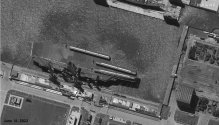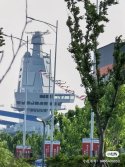Looking forward to having this beauty sail up and down the aea of japanBecause that's where Japan is.
You are using an out of date browser. It may not display this or other websites correctly.
You should upgrade or use an alternative browser.
You should upgrade or use an alternative browser.
CV-18 Fujian/003 CATOBAR carrier thread
- Thread starter Jeff Head
- Start date
No. The "search" is typically supplied by the Type 364 surface search radar, that round bulb dome you see on the aft mast above the funnel of the Type 054A, the top mast of the 052C/D, and two are located on the Liaoning and Shandong on top of the island. Its also on the Type 071 and 901, and refitted to the Pr 956EM and the 051B.
But on the 055, the Type 364's surface search function is embedded on the X-band MFR that's on the integrated mast. So there is no Type 364 radar on this ship. If you see 003's island, there are both S and X-band radars, which are likely to be inherited from the 055, and so the upper located X-band radars should also serve as the search radars for the CIWS. In addition to that, the Fujian no longer has the two Type 349 used as landing radars, so we have to assume the X-band AESA has also taken over the landing radar function.
On the Type 075, the Type 364's function is replaced by a dual faced rotating AESA on the second mast, which I believe is the Type 368.
The advantage of having a centralized dedicated surface search radar is that this radar has a much greater range, at least 60km to possibly 100km, compared to the tiny search radar on the CIWS. In addition the SSR can be located much higher on the ship to give it a maximum radar horizon, hence why the Type 364 is located at the highest part of the ship its on. This is also why these radars are crucial to the overall defense of the ship, given they have a higher radar horizon than the main search radars embedded on the island or superstructure. This gives an earlier warning when the sea skimming antiship missile pops over the radar horizon.
Removing the search radar off the CIWS, allows the 730/1130 to have a full and independent axis EO with different spectrums and zoom. lengths. If the CIWS has an EO, its usually fixed to the same direction as the gun, so the entire CIWS has to swing around and point to the target for the EO to track it. Having the EO on a separate axis means the EO can independent track a target on a direction different from the gun, and the EO can undertake its own search with it, which can help in heavy interference environments and low RCS targets.
The search radar on the CIWS is where the PLAN choose to differ from other countries' CIWS. Even the Goalkeeper that is alleged where the 730/1130 are inspired from, uses a dedicated search radar in the form of a rotating linear array like a typical ship navigation radar.
But other countries’ ships have a main surface search radar too, so what would Type 364 have over those ships?
I do see that the Korean CIWS have fixed EO windows, whereas 1130 can rotate, but would EO search interfere with radar? There are on different wavelengths, no? I imagine it can’t be mechanical interference either since the LIG concept has the panels fixed to the turret body.
Excuse if this is slightly off topic, but since this system is unique to the Fujian at this moment, I figure it might give additional insights to the sensor suite.
It looks like the lights are on.
View attachment 91128
Just worklights inside, I'd be surprised if it was the ship's own hotel load.
is it possible they simply didn't bother integrating it with their SSR? I'm assuming the 1130/730s are made to be compatible with type 364 from the groundupBut other countries’ ships have a main surface search radar too, so what would Type 364 have over those ships?
Whereas when you get a phalanx or goalkeeper, they come with their own SSR and if you don't want to use it, you have to do the work of integrating yourself.
Brown one likely tacan,green one date link ?This is what I think:
View attachment 91056
Brown could be IFF, which is new design for the PLAN.
Green could be ESM, seen before on the integrated mast of the 055.
Blue could be CEC, seen before on the mast of 055 and Shandong.
Black is not installed yet, I am not sure yet.
Red could be a continuous wave radar used as a landing radar. It reminds me of the new target emitters on the new batch 054A.
Orange could be ECM, seen before on under the bridge wings of the 055.
The things that go wrong is not the bar or the cables connected. The bar itself is just another thick cable. The risk is anything that is connected to the bus. For a AC grid, if any load (launch motors and flywheels here) runs out of sync with one another, your grid will melt. That is how you get a black out in civilian AC grid when there is a sudden change of load. That is also why you need fuses to prevent the disaster from spreading.
The basics is something like this, an AC grid is a inductor, all its consumers are inductors and capacitors. AC grid will be at a stabilized frequency and phase when all loads are stable. If one consumer changes its power draw, it will be out of sync of the stabilized frequency and phase due to its inductance and capacitance.
Think about a pendulum, the frequency is fixed to its length, the amplitude of the swing can be different. Changing the amplitude is equal to changing power draw in AC grid. Now if a series of pendulum is in sync they won't hit one another, but now you want to increase the amplitude of one, it will hit others therefor put them out of sync before they settle down again. That changing period is the problem for an AC grid.
But we're not talking about AC grids.
It would be MVDC grids on warships and the EMALS is DC as well.
As long as you provide enough cooling and also size the cabling/busbar correctly, it will never fail.
Those light have undoubtedly been on since shortly after the superstructure blocks were installed. They are work lights to facilitate construction work Inside superstructure. They almost certainly draw power from the shore and are not part of the ship’s own internal lighting System.It looks like the lights are on.
View attachment 91128





